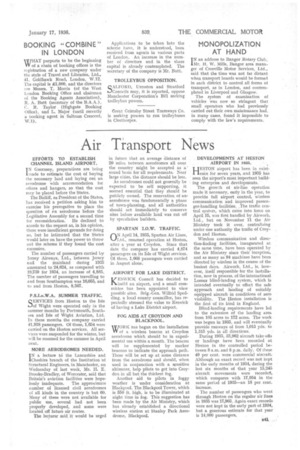Air Tiansport News
Page 55

If you've noticed an error in this article please click here to report it so we can fix it.
EFFORTS To ESTABLISH CHANNEL ISLAND AIRPORT.
I N Guernsey, preparations are being made to estimate the cost of buying the necessary land and laying out an aerodrome with accommodation for offices and hangars, so that the cost may be placed before the States.
The Bailiff, as President of the States, has received a petition asking him to exercise his prerogative to place the question of an aerodrome before the LegiSlative Assembly for a second time for reconsideration. He declined to accede to the request as, in his opinion, there were insufficient grounds for doing so, but he intimated that the States would later on have the power to throw out the scheme if they found the cost excessive.
The number of passengers carried by jersey Airways, Ltd., between jersey and the mainland during 1935 amounted to 24,624, as compared with 19,739 for 1934, art increase of 4,885. The number of passengers travelling to and from Southampton was 16,055, and to and from Heston, 8,567.
P.S.I.o.W.A. SUMMER TRAFFIC.
SERVICES from Heston to the Isle of Wight were operated only in the summer months by Portsmouth, Southsea and Isle of Wight Aviation, Ltd. In these months the company carried 41,938 passengers. Of these, 1,654 were carried on the Heston services. All services were suspended for the winter, but will be resumed for the summer in April next.
MORE AERODROMES NEEDED.
I N a lecture to the Lancashire and Cheshire branch of the Institution 'of Structural Engineers, in Manchester, on Wednesday of last week, Mr. H. E. Brooke-Bradley, of Worcester, said that Britain's aviation facilities were hope lessly inadequate. The approximate number of licensed civil aerodromes of all kinds in the country is but 60. Many of these were not available for public rise, several had not been properly developed, and some were located off future air routes.
The lecturer said it would be urged
in future that an average 'distance of 20 miles between aerodromes all over the country might be accepted as a' sound basis for all requirements. Near large cities, the distance should be less.
As aerodromes could not generally be expected to be self supporting, it seemed essential that they should be publicly owned. The reservation of an' aerodrome was fundamentally a phase of town-planning, and all authorities should act immediately to conserve sites before available land was cut off by speculative builders.
SPARTAN I.O.W. TRAFFIC.
O(IN April 14, 1935, Spartan Air Lines, resumed operation at Heston, after a year at Croydon. Since that date the company has carried 4,874 passengers on its Isle of Wight services. Of these, 1,668 passengers were carried
in August alone.
AIRPORT FOR LAKE DISTRICT.
KESWICK Council has decided to build an airport, and a small committee has been appointed to view possible sites. f3rig-aGen. Wilfrid Spedding, a local county councillor, has repeatedly stressed the value to Keswick of having a Lake District airport.
FOG AIDS AT CROYDON AND BLACKPOOL.
WORK eas begun on the installation VV of a wireless beacon at Croydon aerodrome which should be in experimental use within a month. The beacon will be supplemented by marker beacons to indicate the approach path. These will be set up at some distance from the aerodrome and should, when used in conjunction with a sensitive altimeter, help pilots to get into Croydon in all but the thickest fog.
Another aid to pilots in foggy weather is under consideration at Blackpool. The Blackpool Tower, which is 550 ft. high, is to be illuminated at night time in fog. This suggestion has been made by the Air Ministry, which has already established a directional wireless station at Stanley Park Aerodrome, Blackpool.
DEVELOPMENTS AT HESTON AIRPORT IN 1935.
HESTON airport has been in exist' lenee for seven years, and 1935 has seen the airport's most important build" tug enterprise and develop:heists.
The growth of air-line operation made it necessary, early in the year, to provide full airport control, wireless communication and improved passenger-handling facilities. .The traffic control system, which came into force on April. 15, was first handled by Airwork, Ltd., but on November 11 the Air Ministry took it over, centralizing under one authority the traffic of Croydon and Heston.
Wireless communication and direction-finding facilities, inaugurated at the same time, have been operated by the Air Ministry since their inception, and as many as £14 machines have been directed by wireless in the course of the busiest days. Airwork, Ltd., is, however, itself responsible.-for the installation, now in process, of the international Lorenz blind-landing system, which is intended eventually to effect the safe approach and landing of suitably equipped aircraft. in conditions of zero visibility. The Heston installation is the first of its kind in England.
Blind-lauding requirements have led
to the extension of the landing area from 105 acres to 172 acres. The work was begun in 1935, and will eventually provide runways of from 1,015 yds. to 1,315 yds. in all directions.
During 1935, 33,962 aircraft take-offs
or landings have been recorded at Heston in -the controlled period between 8 a.m. and 8 p.m. daily. Of these 49 per cent, were commercial aircraft Although an exact record was not kept in the early months of 1934, during the last six months of that year 15,245 aircraft movements were recorded, which compares with 17,954 in the same period of 1935—an 18 per cent. increase.
The number of passengers who went through Heston on the regular air lines in 1935 was 17,903. Again exact records were not kept in the early part of 1934, but a generous estimate for that year is 14,000 passengers.




























































































